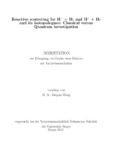Zitierlink:
https://nbn-resolving.org/urn:nbn:de:hbz:467-6960Dateien zu dieser Ressource:
| Datei | Beschreibung | Größe | Format | |
|---|---|---|---|---|
| wang.pdf | 7.42 MB | Adobe PDF |  Öffnen/Anzeigen |
| Dokumentart: | Doctoral Thesis | Titel: | Reactive scattering for H - + H 2 and H + + H 2 and its isotopologues : classical versus quantum investigation | AutorInn(en): | Wang, Dequan | Institut: | Fakultät IV Naturwissenschaftlich-Technische Fakultät | Schlagwörter: | quantum mechanic, energy surfaces, reaction probability, reaction cross section | DDC-Sachgruppe: | 540 Chemie | GHBS-Notation: | UTS | Erscheinungsjahr: | 2013 | Publikationsjahr: | 2013 | Zusammenfassung: | In the present doctoral thesis, the reactive scattering for H- + H2 and H+ + H2 and its isotopologues were investigated using different methods to solve the equations describing classical and quantum mechanics. The studies aimed at providing insights into elementary reactions, and may even go beyond these to more complex chemical reactions. The main results in this dissertation can be summarized as follows: In Chapter 2 the equations solving problems in quasi-classical mechanics were described, which led to the definition of energy dependent reaction probabilities and reaction cross sections. The formalism for time-dependent methods for the investigation of scattering processes was presented in Chapter 3. In this section we discussed how to use the time-dependent quantum wavepacket method to study the A-BC system. The dependence of the reaction probabilities on the total angular momenta J was calculated to obtain information about the integral reactive cross section. The potential energy surfaces (PESs) for H3+ and H3- were described in Chapter 4. For the H3+ system, a cut through the potential energy surface (PES) in the asymptotic region was presented. For the H3- system three available ab initio potential energy surfaces have been used in the applications: a) Stärck and Meyer (SM-PES), b) Panda and Sathyamurthy (PS-PES), and c) Ayouz et al. (AY-PES). The differences in the PESs were investigated. In the beginning of Chapter 5 the H+ + H2(v=0-5, j=0) collision was investigated nonadiabatically. By comparison of the reaction probabilities using adiabatic and non-adiabatic representations of the potential energy surfaces, it was found that, at low collision energies, the reaction preferentially occurs adiabatically, but at higher collision energies non-adiabatic effects have to be taken into account. Reaction probabilities and reaction cross sections for the collision H- with H2 and its isotopologues using quasi-classical trajectories and quantum wavepackets were presented in the main part of Chapter 5. It was found that, at low collision energies, the reaction probabilities using SM-PES and AY-PES are very similar. The reaction probabilities based on the PS-PES are lower than those based on the SM-PES and AY-PES. At lower collision energies the reaction cross sections calculated with SM-PES are higher than those calculated with PS-PES. The reaction cross sections investigated with quasi-classical trajectories are higher than those calculated with quantum wavepackets (using the same potential). The last section of Chapter 5 showed results for the collision of H- and D- with HD. The total I reaction probabilities, the reaction cross sections, and the product ratios were determined using quasi-classical trajectories. One can learn from these calculations that for the H- + HD(v=0-1, j=0) reaction and low collision energies, the main product are H2 + D-. At high collision energies, the product channel HD + H- is slightly dominant. For the collision of D- with HD and low collision energies the product channel HD + D- is strongly favored, but in the high collision energy range, the product channel D2 + H- dominates. |
URN: | urn:nbn:de:hbz:467-6960 | URI: | https://dspace.ub.uni-siegen.de/handle/ubsi/696 | Lizenz: | https://dspace.ub.uni-siegen.de/static/license.txt |
| Enthalten in den Sammlungen: | Hochschulschriften |
Diese Ressource ist urheberrechtlich geschützt. |
Seitenansichten
432
checked on 25.11.2024
Download(s)
185
checked on 25.11.2024
Google ScholarTM
Prüfe
Alle Ressourcen in diesem Repository sind urheberrechtlich geschützt, soweit nicht anderweitig angezeigt.

